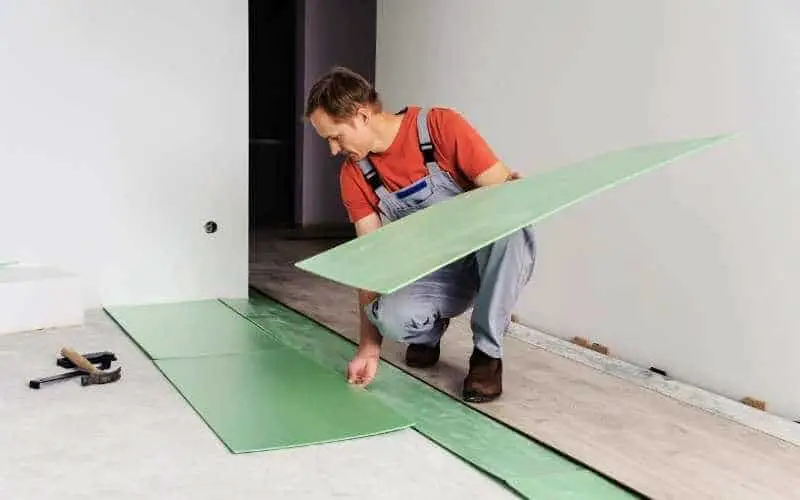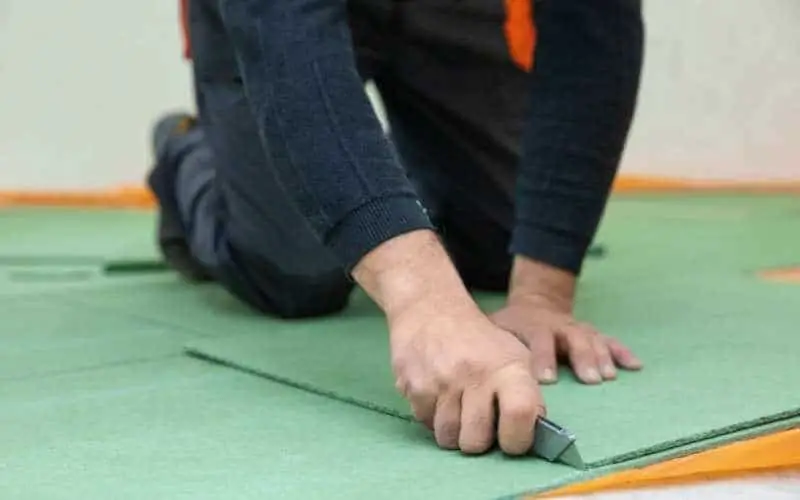Knowing how to install underlayment for vinyl plank flooring and how to do so correctly is very important as it is a costly enterprise, so you want to get it right the first time around.
The installation process begins with preparing the subfloor, after which you can go ahead and roll out the underlayment and secure it to your subfloor using tacks or adhesive.
There are different types of underlayment to choose from, and depending on the type of vinyl planks and area you intend to install them in, you may not need underlayment at all.
Without further ado let’s discuss in-depth, the steps involved in installing underlayment for vinyl plank flooring which begins with you clearing out the area.
How to Install Underlayment for Vinyl Plank Flooring
Table of Contents
To install underlayment for vinyl plank flooring you’ll need a couple of tools and supplies. These includes:
- Carpet tape
- Tape measure
- Utility knife or scissors
- Straightedge
- Broom
Here’s a general instruction on how to go about installing underlayment for vinyl flooring, but remember to read the instructional guide of the underlay product for specific instructions.
1. Prepare the Subfloor
Prepare the subfloor by sweeping and, thoroughly cleaning the area to remove any dry debris that could ruin the underlayment or affect the installation of the vinyl flooring. Pull out any nails sticking up the subfloor and fix any other imperfections that could affect the underlay installation.
If your subfloor is concrete, to prevent moisture seepage you can install a vapor barrier over the concrete before installing the underlayment.
2. Spread Out the Underlayment
When the subfloor is clean and ready, you can begin spreading out the underlayment. Place the roll of underlay material over the vapor barrier or directly over the subfloor.
3. Choose Method of Installation
You can install underlayment for vinyl plank flooring using different ways like gluing, taping, or tacking, especially if the area experiences high levels of foot traffic. If the area receives limited foot traffic you can dry lay the underpayment over the subfloor.
Spread out the roll or tiles from one end of the room to the other. You may need to remove the baseboards in the room so the floor fits perfectly over them especially when using thick underlay or vinyl tiles.
Related: How to install baseboard molding
4. Cut the Underlay to Fit
When you reach an end with the vinyl roll or tile, you can cut it to fit tightly against the wall. You can use a pair of scissors to get the job done if you have an extremely thin roll of underlay or you can use a utility knife and a straightedge if the underlay is thicker and to get a precise cut.
5. Secure the Underlay to the Floor
To secure underlay rolls, you can apply tape along the lengthwise seams of the pieces which should hold them in place. Avoid overlapping the edges of the underlay as this can create an uneven thickness along the seams.
You can also tack down the underlay with tack strips or just let lay dry. This all depends on the type of vinyl flooring you are installing and your needs.
Common Types of Underlayments for Vinyl Flooring
Here are some of the common types of underlayment for vinyl flooring.
1. Foam
Foams are the most affordable underlayments you can buy. If you have a plywood subfloor, foam is often a good choice. But ensure to check out for moisture issues first, you do not want to place foam underlay over a moisture-prone subfloor.
Foam underlay is usually available in rolls and can be purchased in a thicker or thinner width as you need.
2. Felt
Felt has a denser layer than foam, this makes it an excellent underlayment for helping with sound issues. It muffles noise better and is quite insulating. But it’s also quite thin which makes it a little less comfortable.
3. Cork
Cork is also a great sound absorber and is a good choice if you have minor moisture issues, but aren’t exposed to a lot of water. Cork underlay is also great for areas prone to mold and mildew.
4. Particleboard
Particleboard is somewhat a cross between wood and foam. It is quite affordable, but it’s also fragile so your subfloor has to be in excellent condition before opting for this choice. Using particleboard over a subfloor with moisture issues can cause it to rot.
Read: How to deodorize subfloor
5. Plywood
Plywood underlayment is quite similar to particleboard, but it is a bit stronger and withstands water better. However, you would need to ensure that the floor’s weight and items placed over are evenly distributed above it since it can’t handle weight all in one spot.
6. Oriented Strand Board
Oriented strand board (OSB) shares similar qualities to plywood but isn’t quite as durable. Exposure to moisture causes the underlayment to swell, so needs to be installed over a very dry subfloor.
Related: How to cut vinyl floor tiles around a toilet
Conclusion
Before you install underlayment for vinyl plank flooring, you would need to make thorough consideration of your space to enable you to make the right choice of underlayment.
The procedure begins with you preparing the subfloor, then roll out the underlayment and secure using any method of choice. The details of how to install underlayment for vinyl plank flooring which have been discussed, are quite easy to follow.

